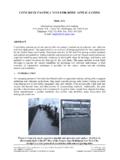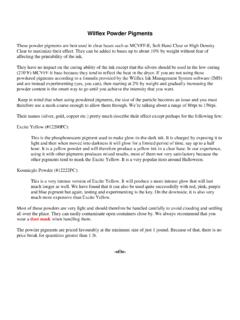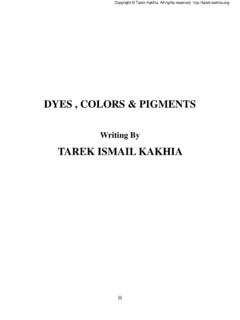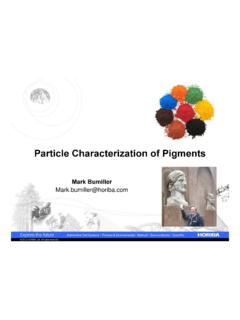Transcription of PRACTICAL METHODS FOR DETERMINING THE TINTING …
1 PAVE 92 63 PRACTICAL METHODS FOR DETERMINING THE TINTING STRENGTH OF pigments IN CONCRETE Or. GOnther Teichmann Technical Service Department Bayer AG. Germany SUTIUUary The TINTING strength of the pigments used to colour con-crete products such as pavers and roof tiles is of particu-lar significance. pigments with high TINTING strength will create a more intense colour than those with lower TINTING strength, even if the same quantities are used. This means that smaller amounts of the pigments with high TINTING strength are needed to create a certain colour intensity. Colorimetry makes it possible to measure TINTING strength under PRACTICAL conditions in the laboratory. To ensure the accuracy of the colorimetric measurements, the concrete surfaces should be as homogeneous as possible and complete-ly free from efflorescence.
2 The method described in this paper makes this possible and is an interesting complement to standard METHODS used to measure TINTING strength in building materials. The TINTING strength values for two pigments of similar shade can be used to calculate the pigment concentrations required to create the same colour intensity. It is also possible to use TINTING strength measurements to draw conclusions about the dispersibility of a pigment in concrete under certain variable mixing conditions. It is interesting to test the pigments in the form of powders, aqueous suspensions or granules. 1 Introduction The German standard DIN 55986 defines TINTING strength as a measure of the ability of a colorant, on the basis of its absorption capacity, to colour other substances. At first glance this definition might appear to be somewhat compli-cated so what does it actually mean?
3 The manufacture of a red concrete paver, for example, re-quires the addition of a colorant, usually referred to as a pigment. Red iron oxide pigments are generally used. These differ in particle size and, to a certain extenty purity. Used in concrete they will result in various shades of red, for example, a yellowish or bluish red. They also have dif-ferent TINTING strengths. The higher the TINTING strength of a pigment is, the less of that pigment will be needed to create a certain colour intensity. TINTING strength is therefore a particularly important factor in the cost-effective use of pigments in concrete and other substances such as plastics and coatings. Generally speaking, TINTING 64 Standards dealing with pigments therefore include METHODS for the measurement of TINTING strength. In most cases the shade is measured at the same time.
4 Information about the TINTING strength of a pigment must always include the medium in which the measurement was taken. paint systems such as alkyd resins are normally used. The simple reason for this is that the test pigment is easily dispersed in resins to produce smooth, clean paint films suitable for measurement with a colour measuring device. Anyone who works with pigments knows from experience that the results of TINTING strength and shade tests carried out in paints cannot simply be applied to other media such as concrete. As far as shade is concerned, a paint binder is generally colourless, it has no natural colour of its own. In concrete, where the cement used as the binder is pigmented, the shade varies depending on the natural colour of the cement itself, whether it is a white cement or a dark portland cement.
5 In adaition, concrete contains aggre-gates as large as 10 mm or more so it is small wonder that the results measured in paints cannot be applied to con-crete. This fact is recognized in the various national standards governing the use of pigments in concrete. The German standard DIN 53237 " pigments for cement and lime-bound building materials" describes a method for mea-suring TINTING strength. The test pigment is mixed dry with white cement or barytes and the TINTING strength determined visually or colorimetrically. This method is quick and easy and the values obtained approximate those found in con-crete. The British standard BS 1014: 1975 describes a similar method. The pigment and the cement are either mixed dry be-tween two glass tiles or with water and then assessed visually. In both METHODS the pigment and cement or barytes are mixed thoroughly with the aid of glass beads.
6 The best results are achieved using a shaking machine. However, in both cases no aggregate is added and it is this which ensures the optimum dispersion of pigments in concrete. It is therefore necessary to develop a method where the pigment is mixed with cement, various aggregates and water, and the TINTING strength is measured after the concrete has hardened, preferably not visually but with a colour measur-ing device. Just such a method is described in the following para-graphs. It is intended to complement the existing METHODS as laid down in various standards. 65 2 Method for DETERMINING the relative TINTING strength Basic principles TINTING strength is always determined relatively, the TINTING strength of a reference pigment is taken to be 100 % and that of the test pigment as higher or lower in relation to this.
7 When measuring the relative TINTING strength of the pig-ments ~ommonly used in concrete in accordance with German standard DIN 5598b, the tristimulus value Y = Ry is used as the TINTING strength criterion. Ry characterizes the light-ness of a colour. Numerous comparative studies have shown this value to be the most closely compatible with the visual assessment made by colorists. As most modern colour measuring devices measure Rx and Rz as well as Ry, other colorimetric values are determined in addition to the relative TINTING strength (a*, b*, L*, C*) which aid a more complete characterization of a colour. They are calculated from Rx, Ry and Rz. It is not possible within the scope of this paper to go into great detail about these colorimetric values. I can refer you to manufacturers' information [1], papers [2] and general trade publications [3].
8 A basic knowledge of the principles of colorimetry are sufficient for it to be of some use in solving the problems encountered with coloured concrete. As the human eye is very sensitive, it is to be recommended that any values given are always confirmed and compared by visual assess-ment and not merely taken at face value. Manufacture and measurement of concrete samples The surfaces to be measured by colorimetric METHODS must be free from any efflorescence (calcium carbonate) which could produce wildly inaccurate results. It is not recommended that the concrete samples are manufactured and then broken, the measurements being taken on the broken surfaces, because most colour measuring devices only function proper-lyon a smooth surface where no light can seep in at the sides. Only those instruments which operate without touch-ing the sample, and these are few, do not have this disad-vantage.
9 Careful formulation and selection of the various aggregates (see appendix) will result in relatively smooth concrete surfaces free from efflorescence. The next paragraphs des-cribe only the principles of the method. The exact proce-dure can be found in the appendix. It is also essential that the aggregate used is no larger than 2 mm. A certain quantity of extender must also be to 2 mm quartz powder to an equivalent calcium silicate powder. Experiments showed that this had no effect on the results. Any aggregate used should have little natural colour, it should be as close to white as possible. It is therefore advisable to use standard, or at least washed, sand. White cement should be used as only then will the reflec-tance values (Ry greater than 10 if possible) be such that the colour measuring device can operate with sufficient accuracy.
10 Hardening is especially important for reproducibility. It is obvious that temperature, relative atmospheric humidity and time will have an effect. However, it has also been found that the amount of available C02 has an influence on these sensitive measurements. Many laboratories are not equipped with a climatic chamber and, even if they do have one, the C02 content cannot be kept uniform because of the varying number of concrete samples and the constant opening and closing of the door. For this reason, we employ a simple but very PRACTICAL method. Four concrete samples are placed on a wooden rack (Fig. 1). This is then place in a polythene bag which is sealed (Fig. 2). There are sidepieces on the rack to keep the polythene bag from touching the concrete samples. This pre-vents condensation water from soaking into the concrete.













